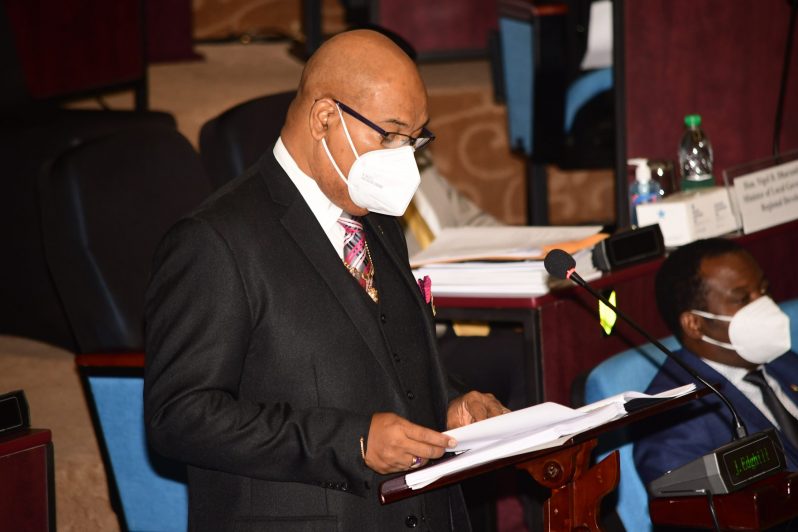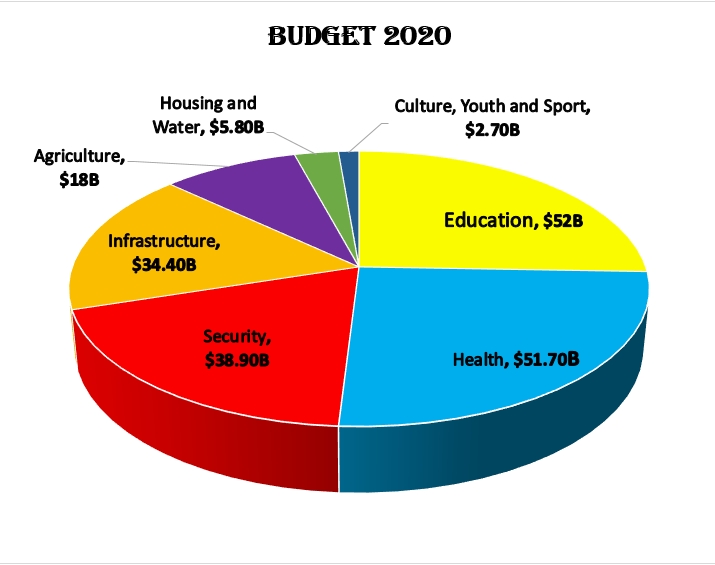— as gov’t moves to cushion effects of COVID-19, revitalise productive sectors
By Navendra Seoraj
AS the world faces an uncertain future because of the novel coronavirus (COVID-19) pandemic and other global events, Guyana is better poised to emerge from the crisis rapidly, with a more resilient economic base, said Minister of Public Infrastructure, Juan Edghill, as he presented government’s $329.5B budget to the National Assembly, on Wednesday.
The country, though faced with the challenges associated with the pandemic and a recently concluded protracted electoral process, is poised to grow by between 48.4 per cent and 51.2 per cent by the end of this year.
Guyana had recorded an estimated real Gross Domestic Product (GDP) growth of 45.6 per cent at mid-year. This growth was driven mainly by the country’s petroleum sector, as the non-oil economy contracted by 4.9 per cent due to significant declines recorded across many major industries.
“This was, in part, due to the protracted General and Regional Elections, but also a result of the significant reduction in economic activity after the introduction of several emergency measures in the second quarter to curb the spread of COVID-19,” said Minister Edghill.
These measures saw restrictions being imposed on the movement of persons and operation of non-essential businesses, which, in turn, led to a reduction in household income.
While there was a phased relaxation of measures in the third quarter of the year, a surge in COVID-19 cases in August has necessitated the reintroduction of more stringent measures. The need to constantly monitor and readjust emergency measures in response to the spread of COVID-19 increased uncertainty surrounding the economic performance of various industries for the remainder of this year, said the minister.
To this end, a few different scenarios were considered in forecasting growth and other macroeconomic indicators for 2020. And, while real GDP growth could reach 51.2 per cent, the non-oil economy is expected to contract by between 1.4 per cent and 4.3 per cent.
Speaking about the agriculture, forestry and fishing industries, Minister Edghill said they contracted by 4.1 per cent in the first half of the year, as a result of lower production in the “other crops,” livestock, forestry and fishing industries. Those industries are projected to decline further by between 0.1 per cent and 2.3 per cent by the end of this year.
Turning to specific industries, sugar, which expanded by 10.4 per cent at the half-year, is expected to grow by between 10 per cent and 15.4 per cent. Expansion is also expected in rice growing, with forecasts for second crop production anticipated to result in growth of between 2 and 3.5 per cent.
The livestock industry, which contracted by 2.3 per cent at the half-year, is expected to rebound in the second half, to realise growth of between 0 per cent and 2.4 per cent in 2020.
The mining and quarrying industries, which expanded by a mammoth 343.7 per cent by mid-year due to petroleum and by a lesser extent gold, are expected to expand by between 320.6 per cent and 324.3 per cent by year-end.
The gold mining industry, which expanded by 2.1 per cent at the half-year, also experienced some setbacks, particularly with the two large scale companies, who together reported a 36 per cent decline in production, when compared with the same period in 2019.
While large scale production is expected to continue to dwindle in the second half, the output of small and medium scale miners, in response to higher prices, is expected to bolster production, pushing growth to fall between -2 per cent and 0.7 per cent.
“The bauxite industry continues to face reduced global demand for its output, which, in addition to the stoppage of mining by one company, resulted in a contraction of 42.3 per cent at the half-year.
“This industry is expected to contract by between 40 and 51 per cent in 2020. Similarly, the other mining industries also saw a significant contraction at the half-year, by 56.8 per cent, as a result of lower demand. However, the resumption of construction activities is expected see improved output in the second half, resulting in a less severe contraction of between 20 per cent and 30 per cent in this industry,” said Minister Edghill.
The construction industry contracted by 5.6 per cent at mid-year, despite the emergency measures gazetted in April which were expected to result in a more severe decline. While the formal easing of restrictions on construction activities in the second half of the year, and the resumption of public sector construction should not result in a significant decline in the industry, it is still expected to contract, by between 4 and 7 per cent in 2020.
CONTRACTIONS
Similarly, the service industries, which are expected to be worst hit by the emergency measures to curb the COVID-19 pandemic, contracted by 3.8 per cent in the first half of the year, with most industries suffering severe contractions.
Wholesale and retail trade and repairs contracted by 14.7 per cent; transport and storage by 25 per cent; accommodation and food services by 32.9 per cent; professional, scientific and technical services by 20.7 per cent; administrative and support services by 5.3 per cent; arts, entertainment and recreation by 45.8 per cent; and other services by 51.2 per cent.
While the conclusion of the elections has led to improved consumer sentiment and an expectation of improved performance in some of the service industries, the unpredictability of the COVID-19 pandemic threatens to dampen any recovery. As such, service industries are forecasted to contract by between 0.7 per cent and 3.5 per cent, in 2020.
Minister Edghill further said the manufacturing industries contracted by 0.2 per cent in the first half of the year, despite expansions in sugar and rice manufacturing, by 14.2 per cent and 7.2 per cent respectively.
This was due to a significant contraction, of 5.7 per cent, in the “other manufacturing” industries. While the output of these industries is expected to improve in the second half amidst growing demand, “other manufacturing” is still expected to contract by between 1 per cent and 5 per cent in 2020. Overall, the performance of the manufacturing industry in 2020 is projected to fall between a contraction of 1.4 per cent and an expansion of 1.9 per cent.
EXPORT EARNINGS
On a more positive note, Minister Edghill said export earnings are projected to increase by 58.4 per cent to US$2.5 billion, supported by the exports of crude oil in 2020. Guyana has already earned over US$140 million from the sale of crude.
Continued growth is projected in the export earnings of rice and paddy, and gold, of 10 per cent and 15.8 per cent, respectively. These are expected to offset an anticipated decline in export earnings from the other sectors.
Central government’s current revenue is, however, estimated at $226.5 billion, 5.9 per cent or $14.1 billion, below 2019 collections, as a result of lower anticipated collections from both tax and non-tax revenue sources.
Tax revenue, in 2020, is estimated at $214.5 billion, $11.4 billion less than the $226 billion collected in 2019. This is on account of reduced economic activity and the introduction of measures by the Guyana Revenue Authority (GRA), to reduce the burden on both businesses and individuals, amid the COVID-19 pandemic.
“While this Budget (budget 2020) will focus primarily on addressing the health and economic crises resulting from the pandemic, in the medium-term, investments will focus on creating the conditions to catapult Guyana towards prosperity, such that all of our people reap the benefits of the petroleum revenue windfall,” said Minister Edghill.
These investments, he said, will be grounded in the tenets of the Low Carbon Development Strategy (LCDS) – low deforestation, low carbon, climate resilient economy. In this regard, budget agencies will, over the coming months review and update medium-term strategies to ensure that Guyana is able to deliver transformative development.
“We are also mindful of the volatility inherent in petroleum revenues, as well as the risk of overheating the economy by spending too much too quickly. As such, the medium term-fiscal framework will see a paced and conservative ramp up in spending, financed by the prudent use of petroleum revenues and decreasing reliance on debt,” Minister Edghill explained.
Budget 2020 is being presented near the end of the third quarter of the year so expenditure would have been accumulated in the first half of the year to ensure the continuation of multi-year projects and programmes, and provision of public services in the middle of the pandemic. The size of Budget 2020 is $329.5 billion, which is 9.6 per cent, or $28.8 billion, above that of 2019.
“The year 2020 has been a complicated and difficult one for us as Guyanese. We have gone through testing times as a nation, given our own internal struggles, of living together as one people; but, it is clear that we have one destiny. As Guyanese, we must all make every effort to heal and to move forward together, as we consolidate our national position in order to achieve our development trajectory ahead,” said Minister Edghill.
ADDITIONAL CRISIS
The pandemic presents an additional crisis that will continue to affect all spheres of life; and, as the country adapts to this new normal, Minister Edghill said one lesson rings true, “how we act as individuals will ultimately impact the lives of those around us, whether we apply that to the prevention of the spread of COVID-19, or to our engagement as mutual respecting citizens of our beloved country.”
The minister believes that budget 2020 offers hope and relief in its measures, and programmes and projects. It reflects government’s fierce dedication to ensuring a better quality of life for all Guyanese.
“Our Government will continue to fiercely defend our cherished democracy as we have recently done, and we will always champion upholding the rule of law.
“We will continue, as always, to secure working partnerships with our private sector – from the fruit vendors to the rum producers, farmers to fishers, miners to millers, air service providers to minibus drivers. We will work within the public sector with all diligent public servants, including soldiers, police, educators, and health workers – especially those who are on the frontline – to ensure effective delivery of public services to all Guyanese, particularly at this crucial time,” said Minister Edghill.
Government’s “plan for prosperity,” despite the challenges, has taken root in this emergency budget, and Budget 2021 will outline the transformative agenda for the medium-term; one that is inclusionary and participatory in its architecture and implementation.




.png)










